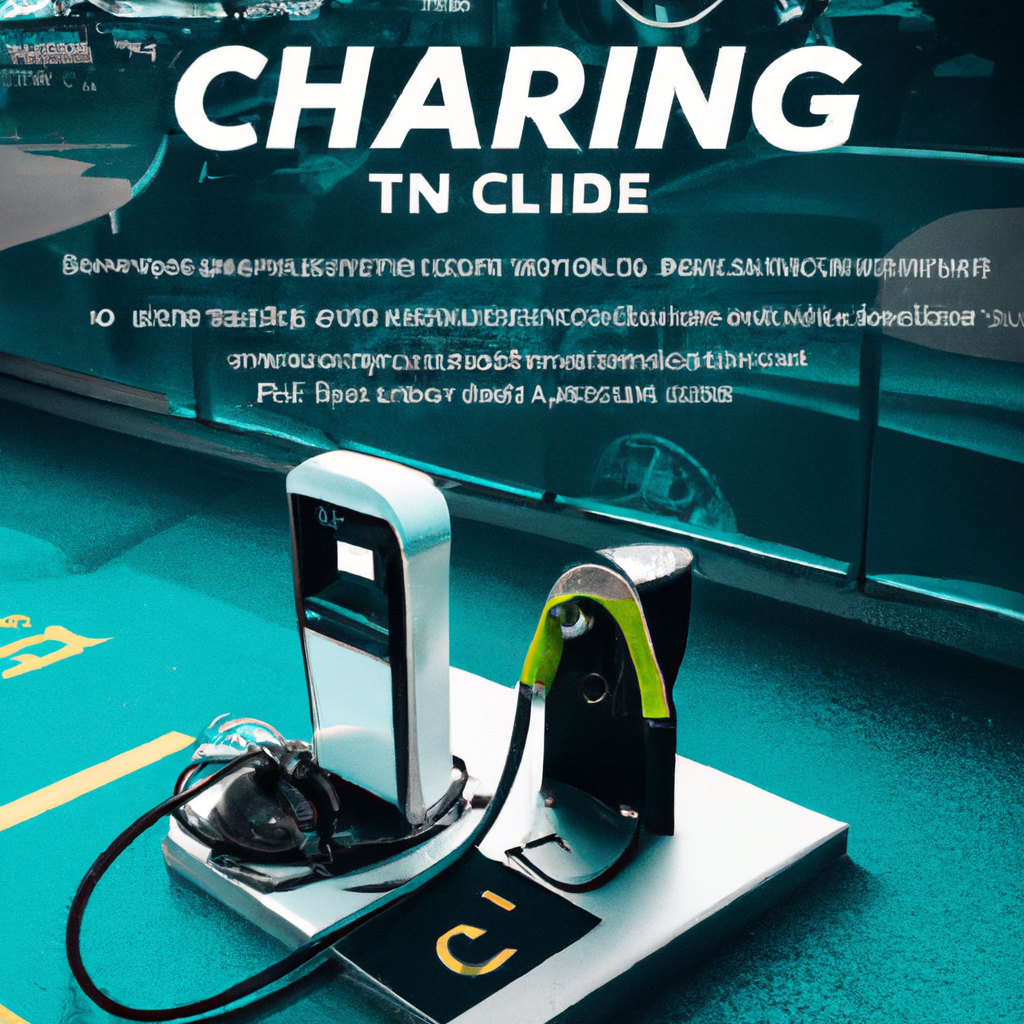Looking to learn about the exciting world of electric vehicles and the ever-growing network of charging stations? Look no further than Currentcarreport.com, your go-to source for all things EV-related. Offering a comprehensive guide to the latest models, advancements in battery technology, and insights into global market trends, our platform is designed to keep you informed and prepared for the electric shift in transportation. On top of that, we provide an extensive directory of charging stations, reviews on the best home chargers, and updates on the advancements in fast-charging infrastructure. Whether you’re an EV enthusiast, a potential buyer, or simply curious about the future of mobility, EV Nexus is here to be your electrifying compass.

This image is property of images.pexels.com.
The Rise of Electric Vehicles (EVs)
Electric vehicles (EVs) have become increasingly popular in recent years, revolutionizing the transportation industry. As concerns over climate change and air pollution continue to grow, people are becoming more interested in finding sustainable alternatives to traditional vehicles that rely on fossil fuels. In this comprehensive guide, we will explore the various aspects of the electric vehicle industry, including the advantages of electric vehicles over traditional vehicles, key players in the market, technological advancements, and more.
Overview of the Electric Vehicle Industry
The electric vehicle industry has witnessed significant growth in recent years, driven by advancements in battery technology, government support, and increased consumer demand. According to recent reports, the global electric vehicle market is expected to grow at a steady rate over the coming years. This growth can be attributed to the numerous benefits that electric vehicles offer compared to their gasoline-powered counterparts.
Advantages of Electric Vehicles over Traditional Vehicles
One of the main advantages of electric vehicles is their environmental impact. EVs produce zero tailpipe emissions, reducing air pollution and greenhouse gas emissions. Additionally, electric vehicles are more energy-efficient compared to traditional vehicles, as they convert a higher percentage of stored energy into motion. This higher efficiency leads to lower energy consumption and reduced dependence on fossil fuels.
Electric vehicles also offer cost savings over the long run. While the upfront cost of purchasing an electric vehicle may be higher than that of a traditional vehicle, EV owners can benefit from lower operating and maintenance costs. Charging an electric vehicle is generally cheaper than refueling a gasoline-powered vehicle, and EVs have fewer moving parts, resulting in lower maintenance and repair costs.
Another significant advantage of electric vehicles is their quiet operation. Unlike internal combustion engines that produce noise and vibrations, electric vehicles offer a smoother, quieter driving experience. This can greatly enhance driving comfort and reduce noise pollution in urban areas.
Key Players in the Electric Vehicle Market
Several major automakers have entered the electric vehicle market, contributing to its rapid growth. Companies such as Tesla, Nissan, Chevrolet, BMW, and Volkswagen have been at the forefront of developing innovative electric vehicles and driving the industry forward. Tesla, in particular, has been instrumental in popularizing electric vehicles with its range of high-performance, long-range EVs. These key players continue to invest in research and development, driving advancements in battery technology and improving the range and performance of electric vehicles.

This image is property of images.pexels.com.
Technological Advancements in EVs
Technological advancements in the electric vehicle industry have been critical in improving the performance and range of EVs. The development of lithium-ion batteries has revolutionized the industry by providing higher energy density and longer driving ranges. These advancements have made electric vehicles more practical and appealing to a wider range of consumers.
Furthermore, research is ongoing in areas such as solid-state batteries, which have the potential to further enhance the range and charging capabilities of electric vehicles. Other technological advancements, such as regenerative braking systems and improved electric powertrains, have also contributed to the overall efficiency and performance of electric vehicles. As technology continues to advance, we can expect even more exciting developments in the electric vehicle industry.
Types of Electric Vehicles
Electric vehicles can be broadly categorized into four main types: Battery Electric Vehicles (BEVs), Hybrid Electric Vehicles (HEVs), Plug-in Hybrid Electric Vehicles (PHEVs), and Fuel Cell Electric Vehicles (FCEVs). Each type has its own set of advantages and considerations that potential buyers should be aware of.
Battery Electric Vehicles (BEVs)
Battery Electric Vehicles, or BEVs, are fully electric vehicles that rely solely on battery power. These vehicles do not have an internal combustion engine and are powered entirely by electricity stored in their battery packs. BEVs offer several advantages, including zero tailpipe emissions, lower operating costs, and a quiet driving experience. However, one limitation of BEVs is their limited range, which is dependent on the size and capacity of their battery packs.
Hybrid Electric Vehicles (HEVs)
Hybrid Electric Vehicles, or HEVs, combine an internal combustion engine with an electric motor and a battery pack. The electric motor assists the engine to improve fuel efficiency and reduce emissions. HEVs do not need to be plugged in to charge the battery pack, as it is charged through regenerative braking and the internal combustion engine. HEVs offer better fuel efficiency compared to traditional vehicles, but they do not have the same level of environmental benefits as fully electric vehicles.
Plug-in Hybrid Electric Vehicles (PHEVs)
Plug-in Hybrid Electric Vehicles, or PHEVs, are similar to HEVs but with a larger battery pack. PHEVs can be charged by plugging them into an external power source, which allows for a longer all-electric range compared to HEVs. PHEVs can operate in electric-only mode for shorter distances, but they also have a gasoline engine for longer trips. The ability to switch between electric and gasoline power makes PHEVs more flexible than BEVs in terms of range.
Fuel Cell Electric Vehicles (FCEVs)
Fuel Cell Electric Vehicles, or FCEVs, are powered by hydrogen fuel cells that produce electricity through a chemical reaction between hydrogen and oxygen. FCEVs emit only water vapor, making them a zero-emission option. However, the limited availability of hydrogen fueling stations and the high cost of fuel cell technology are currently limiting the widespread adoption of FCEVs.

This image is property of images.pexels.com.
Charging Infrastructure
To support the widespread adoption of electric vehicles, a robust charging infrastructure is essential. The availability of convenient and reliable charging stations plays a significant role in addressing the range anxiety associated with electric vehicles. In this section, we will explore the importance of a robust charging infrastructure, different types of charging stations, public charging station networks, and home charging solutions.
Importance of Robust Charging Infrastructure
A robust charging infrastructure is crucial for the successful integration of electric vehicles into our transportation system. Without a reliable network of charging stations, EV owners may face difficulties finding a place to charge their vehicles, especially during long trips or in areas with limited charging infrastructure. The availability of charging stations is essential for providing peace of mind to electric vehicle owners and encouraging the adoption of electric vehicles.
Different Types of Charging Stations
Charging stations come in various forms, depending on the charging speed and power output they provide. The three main types of charging stations are Level 1, Level 2, and DC fast chargers.
Level 1 chargers are the slowest, typically providing power through a standard household outlet. They are convenient for home charging but may take a long time to fully charge an electric vehicle.
Level 2 chargers offer a faster charging option and require a dedicated charging unit. They are commonly found in public charging stations, workplaces, and commercial areas. Level 2 chargers can charge an electric vehicle in a few hours, depending on the battery size and charging rate.
DC fast chargers, also known as Level 3 chargers, are the fastest charging option available. They can charge an electric vehicle to 80% capacity in as little as 20-30 minutes. DC fast chargers are typically found along highways and major travel routes, providing a convenient option for long-distance travel.
Public Charging Station Networks
Public charging station networks are essential for EV owners who do not have access to home charging solutions or need to charge their vehicles on the go. These networks are operated by various charging service providers and offer a range of charging speeds and payment options. Some charging station networks require a membership or subscription, while others offer pay-as-you-go options. The establishment of widespread public charging networks contributes to the growth and accessibility of electric vehicles.
Home Charging Solutions
Home charging solutions are an essential component of the electric vehicle ecosystem, allowing EV owners to conveniently charge their vehicles overnight. Home charging equipment, also known as Electric Vehicle Supply Equipment (EVSE), includes Level 1 and Level 2 charging units that are installed at an EV owner’s residence. Home charging units provide a cost-effective and efficient way to charge electric vehicles, as they utilize the existing electrical infrastructure. Homeowners can choose to install a Level 1 charger using a standard outlet or opt for a faster Level 2 charger that requires professional installation.
Types of Charging Connectors
Charging connectors play a crucial role in facilitating the connection between electric vehicles and charging stations. Different regions and vehicle manufacturers have adopted various charging connector standards. In this section, we will explore some of the commonly used charging connectors, including CHAdeMO, CCS (Combined Charging System), Tesla Supercharger, Type 2 (Mennekes), and Type 1 (SAE J1772).
CHAdeMO
CHAdeMO is a fast charging standard primarily used by Japanese automakers such as Nissan and Mitsubishi. It is a DC charging connector that allows for high-power charging of electric vehicles. CHAdeMO connectors can be found in many public charging stations, enabling efficient charging for compatible vehicles.
CCS (Combined Charging System)
The Combined Charging System, or CCS, is a combined AC and DC charging connector that has gained widespread adoption in Europe and North America. CCS connectors can handle both AC and DC charging, allowing for a more flexible and standardized approach to electric vehicle charging. CCS connectors are often used in public fast charging stations and are compatible with a wide range of electric vehicle models.
Tesla Supercharger
Tesla Superchargers are proprietary charging connectors designed specifically for Tesla electric vehicles. These high-power DC fast chargers are capable of delivering rapid charging speeds to Tesla vehicles, allowing for convenient long-distance travel. Superchargers are primarily located along major travel routes and within the Tesla Supercharger network, providing Tesla owners with a reliable and efficient charging solution.
Type 2 (Mennekes)
Type 2 connectors, also known as Mennekes connectors, are widely used in Europe for AC charging. They are capable of providing both single-phase and three-phase AC charging options, making them versatile for different charging requirements. Type 2 connectors are typically used with Level 2 charging stations and are compatible with a range of European electric vehicle models.
Type 1 (SAE J1772)
Type 1 connectors, also known as SAE J1772 connectors, are commonly used in North America for AC charging. They are known for their compatibility with most electric vehicle models in the region. Type 1 connectors are typically used with Level 1 and Level 2 charging stations, providing a reliable charging solution for electric vehicle owners.

Fast Charging Technology
Fast charging technology has been a game-changer for electric vehicles, addressing one of the main concerns of EV owners – charging time. In this section, we will provide an overview of fast charging, discuss different fast charging standards, and explore the advantages and limitations of fast charging. We will also look into future developments in fast charging technology.
Overview of Fast Charging
Fast charging is a technology that enables electric vehicles to charge at a significantly higher rate compared to standard charging methods. While standard charging can take several hours, fast charging can provide a significant boost to an electric vehicle’s battery capacity within a short period. Fast charging has made it possible for electric vehicle owners to travel longer distances without the need for extended charging stops.
Different Fast Charging Standards
There are several fast charging standards in use around the world, each with its own specifications and connectors. The most common standards include CHAdeMO, CCS, and Tesla Supercharger. These standards enable high-power DC fast charging and are supported by various electric vehicle models.
Advantages and Limitations of Fast Charging
Fast charging offers numerous advantages, including reduced charging time, convenience, and the ability to undertake long-distance travel without significant delays. With the availability of fast charging stations along major travel routes, electric vehicle owners can plan their trips with confidence, knowing that they can charge their vehicles quickly when needed.
However, fast charging also has its limitations. Rapid charging can cause increased heat buildup in the battery, which may lead to reduced battery life over time. Additionally, not all electric vehicles are compatible with every fast charging standard, which can pose challenges for owners of specific EV models. It is essential for EV owners to ensure compatibility with the available fast charging standards in their region before embarking on long-distance travel.
Future Developments in Fast Charging
As technology continues to advance, we can expect further developments in fast charging technology. One promising area of research is ultra-fast charging, which aims to deliver even higher charging speeds, reducing the charging time for electric vehicles even further. Additionally, advancements in battery technology and charging infrastructure are expected to contribute to future developments in fast charging, making it more accessible and efficient.
Battery Technology and Range
The range of electric vehicles, or the distance they can travel on a single charge, is a crucial consideration for potential EV owners. Battery technology plays a significant role in determining the range and performance of electric vehicles. In this section, we will explore advancements in battery technology, factors affecting EV range, and improvements in battery range.
Advancements in Battery Technology
Battery technology has advanced significantly in recent years, paving the way for improved range and performance in electric vehicles. Lithium-ion batteries, the most commonly used battery type in EVs, have seen substantial improvements in energy density, allowing for more energy storage in a smaller package. These advancements have contributed to increased driving ranges and enhanced overall performance for electric vehicles.
Other areas of battery technology research include solid-state batteries and lithium-sulfur batteries, which have the potential to offer even higher energy densities and improved safety. As these technologies continue to evolve and mature, we can expect further breakthroughs in electric vehicle battery technology.
Factors Affecting EV Range
Several factors can affect the range of an electric vehicle. One of the primary factors is the size and capacity of the vehicle’s battery pack. Larger battery packs can store more energy, resulting in a longer driving range. Additionally, driving conditions, including speed, terrain, and weather, can impact an electric vehicle’s range.
Certain external factors, such as the use of air conditioning or heating, can also affect the range of electric vehicles. Energy-intensive features, such as a high-powered sound system or excessive use of auxiliary electronics, can contribute to increased power consumption and reduced range.
Improvements in Battery Range
Improvements in battery range have been a significant focus for electric vehicle manufacturers. As battery technology continues to advance, the driving range of electric vehicles has increased significantly. Many modern electric vehicles offer ranges of over 200 miles on a single charge, with some high-end models even surpassing 300 miles.
The availability of high-capacity battery packs and advancements in energy management systems have contributed to these improvements. Battery manufacturers are continually working to develop batteries with higher energy densities, longer lifespans, and faster charging capabilities. As a result, electric vehicle owners can now enjoy increased range and the confidence to undertake longer trips without range anxiety.

Benefits of Electric Vehicles
Electric vehicles offer a range of benefits, from environmental advantages to cost savings and improved health outcomes. In this section, we will explore the benefits of electric vehicles and how they contribute to a more sustainable and efficient transportation system.
Environmental Advantages
One of the most significant benefits of electric vehicles is their positive impact on the environment. EVs produce zero tailpipe emissions, meaning they do not emit pollutants or greenhouse gases while driving. This significantly reduces air pollution and improves overall air quality, leading to healthier communities and reduced environmental damage.
Electric vehicles also contribute to the reduction of carbon emissions and help combat climate change. As the electricity grid becomes greener and more renewable energy sources are integrated, the carbon footprint of electric vehicles decreases even further.
Reduced Dependence on Fossil Fuels
The transportation sector heavily relies on fossil fuels, which are finite resources with numerous environmental and geopolitical implications. Electric vehicles offer a solution to reducing our dependence on fossil fuels. By transitioning to electric vehicles and utilizing renewable energy sources, we can promote energy independence and contribute to a more sustainable energy future.
Cost Savings of Owning an Electric Vehicle
While electric vehicles may have a higher upfront cost compared to traditional vehicles, they offer significant long-term cost savings. The cost of electricity for charging an electric vehicle is generally lower than the cost of gasoline or diesel. Additionally, electric vehicles have fewer moving parts and reduced maintenance requirements compared to internal combustion engines, leading to lower maintenance and repair costs over the vehicle’s lifetime.
Several governments and municipalities also offer incentives and rebates to promote the adoption of electric vehicles. These incentives can include tax credits, grants, and reduced registration fees, further reducing the overall cost of owning an electric vehicle.
Health and Societal Benefits
The transition to electric vehicles can have numerous health and societal benefits. As electric vehicles produce zero tailpipe emissions, they contribute to improved air quality, reducing the health risks associated with air pollution. This can lead to fewer respiratory problems and other related health issues, benefiting both individuals and communities.
Furthermore, the adoption of electric vehicles can help create new job opportunities in the clean energy and manufacturing sectors. As the demand for electric vehicles and charging infrastructure continues to grow, there will be a need for skilled workers in these industries. The electrification of transportation can contribute to economic growth and job creation.
Government Policies and Incentives
Government support plays a crucial role in the widespread adoption of electric vehicles. In this section, we will provide an overview of government policies and incentives aimed at promoting and supporting the electric vehicle industry. We will explore incentives and rebates for EV owners, charging infrastructure funding, and future policy trends.
Overview of Government Support for Electric Vehicles
Governments around the world have recognized the importance of electric vehicles in reducing greenhouse gas emissions and combating climate change. As a result, many countries have implemented policies and incentives to encourage the adoption of electric vehicles. These policies can include financial incentives, grants, tax credits, and regulatory measures that promote the development and use of electric vehicles.
Additionally, governments often collaborate with stakeholders in the electric vehicle industry to develop strategies and initiatives that foster the growth of the industry. By providing support and creating a favorable regulatory environment, governments play a crucial role in accelerating the transition to electric vehicles.
Incentives and Rebates for EV Owners
One of the most common forms of government support for electric vehicles is the provision of incentives and rebates for EV owners. These incentives can vary by region and may include tax credits, grants, and rebates for the purchase or lease of electric vehicles. Governments may also offer incentives for EV charging equipment installation and energy infrastructure upgrades.
These incentives aim to lower the upfront cost of electric vehicles, making them more affordable and accessible to a wider range of consumers. By reducing the financial barriers to electric vehicle ownership, governments incentivize consumers to choose electric vehicles over traditional gasoline-powered vehicles.
Charging Infrastructure Funding
To support the growth of the electric vehicle industry, governments often allocate funds for the development of charging infrastructure. This funding can be used to install public charging stations, upgrade electrical infrastructure, and support research and development in charging technologies.
By investing in charging infrastructure, governments help address one of the main barriers to electric vehicle adoption – range anxiety. The availability of convenient and reliable charging stations is essential to ensure the successful integration of electric vehicles into our transportation system.
Future Policy Trends
As the electric vehicle industry continues to evolve, governments are expected to implement more comprehensive and ambitious policies to promote sustainable transportation. Future policy trends may include stricter emission standards for traditional vehicles, increased investment in charging infrastructure, and the promotion of renewable energy sources for vehicle charging.
Governments are also likely to collaborate with other stakeholders, including automakers, utilities, and charging infrastructure providers, to develop holistic approaches to electric vehicle adoption. The alignment between government policies and industry stakeholders is essential for creating a supportive ecosystem that encourages the growth of the electric vehicle market.
The Role of Renewable Energy
The integration of renewable energy sources with electric vehicles offers numerous benefits, ranging from reduced greenhouse gas emissions to increased energy efficiency. In this section, we will explore the role of renewable energy in the electric vehicle ecosystem, its impact on the electric grid, advantages of coupling EVs with renewable energy, and future possibilities.
Integration of Renewable Energy with EVs
Renewable energy sources, such as solar and wind power, provide a sustainable and clean energy alternative to traditional fossil fuels. When electric vehicles are charged using renewable energy, their environmental benefits are further amplified, as they contribute to a significant reduction in greenhouse gas emissions.
The integration of renewable energy with electric vehicles involves utilizing renewable energy sources to generate electricity for vehicle charging. This can be achieved through on-site renewable energy generation, such as solar panels installed at homes or businesses, or through grid-connected renewable energy sources.
Impact on the Electric Grid
The widespread adoption of electric vehicles has the potential to impact the electric grid, particularly during peak charging periods. The integration of large numbers of electric vehicles without proper grid management could lead to strain on the grid and increased demand for electricity.
However, when managed effectively, electric vehicles can actually help balance the electric grid by providing grid services, such as vehicle-to-grid (V2G) capabilities. V2G technology enables electric vehicles to discharge stored energy back to the grid during times of peak demand, helping to stabilize the grid and reduce the need for additional power generation.
Advantages of Coupling EVs with Renewable Energy
Coupling electric vehicles with renewable energy offers several advantages. Firstly, it reduces the carbon footprint of the transportation sector, contributing to a more sustainable and environmentally friendly transportation system. Secondly, it promotes energy independence by utilizing locally generated renewable energy for vehicle charging, reducing dependence on imported fossil fuels.
Furthermore, coupling electric vehicles with renewable energy can lead to lower electricity costs, as renewable energy is often cheaper and more stable in price compared to fossil fuels. As the prices of renewable energy continue to decrease, the cost of electric vehicle ownership and operation is expected to become even more attractive.
Future Possibilities
The future holds great potential for the integration of electric vehicles with renewable energy. Advancements in battery technology and smart grid management systems will enable more effective deployment of electric vehicle charging infrastructure and better utilization of renewable energy sources.
Additionally, the growth of vehicle-to-grid technologies and bidirectional charging capabilities will allow electric vehicles to play a more significant role in balancing the electric grid. Electric vehicles could potentially act as mobile energy storage devices, storing excess renewable energy during times of low demand and discharging it back to the grid during peak periods.
Challenges and Future Outlook
While electric vehicles offer numerous benefits and the industry is experiencing significant growth, there are still challenges to overcome for widespread adoption. In this section, we will explore some of the challenges facing the electric vehicle industry and provide insights into the future outlook of electric vehicles.
Range Anxiety and Charging Time
Range anxiety refers to the fear or concern of an electric vehicle running out of battery power before reaching its destination or the next charging station. Although the range of electric vehicles has improved significantly, addressing range anxiety remains a challenge for potential EV owners.
Additionally, charging time continues to be a limiting factor for electric vehicle adoption. While advancements in fast charging technology have reduced charging times, long charging stops during long trips can still be a deterrent for some consumers.
However, as battery technology continues to improve and the charging infrastructure becomes more widespread, these challenges are expected to diminish. The development of ultra-fast charging technology and the deployment of high-power charging stations will further reduce charging times, making electric vehicles a more viable option for long-distance travel.
Expanding Charging Infrastructure
Expanding the charging infrastructure to meet the growing demand for electric vehicles is a significant challenge. While progress has been made in establishing public charging networks, further investments are needed to ensure the availability of charging stations in residential areas, workplaces, and remote locations.
The expansion of charging infrastructure requires collaboration among various stakeholders, including governments, utility companies, and private entities. Continued investment in charging infrastructure will be critical to addressing range anxiety and providing the necessary infrastructure for the widespread adoption of electric vehicles.
Battery Recycling and Sustainability
The sustainability of electric vehicle batteries is a growing concern. While electric vehicle batteries have a long lifespan, they will eventually reach the end of their useful life and need to be replaced. To ensure the environmentally responsible disposal of these batteries, effective recycling and reuse programs need to be in place.
Battery recycling can help recover valuable materials and reduce the environmental impact of disposing of used batteries. As the electric vehicle industry continues to grow, the development of sustainable battery recycling processes and a circular economy for battery materials will become increasingly important.
Autonomous Electric Vehicles
The rise of autonomous vehicles presents both challenges and opportunities for the electric vehicle industry. Autonomous electric vehicles have the potential to further transform the transportation sector, offering increased efficiency, reduced congestion, and improved safety.
However, the development and deployment of autonomous electric vehicles require significant advancements in technology, infrastructure, and regulatory frameworks. Overcoming these challenges will be essential for realizing the full potential of autonomous electric vehicles and their integration into our daily lives.
Electric Vehicle Adoption and Market Projections
Despite the challenges, the future of electric vehicles looks promising. Market projections indicate continued growth in the electric vehicle industry as governments, automakers, and consumers increasingly prioritize sustainability and energy efficiency.
Advancements in battery technology, the expansion of charging infrastructure, and declining production costs are expected to drive the adoption of electric vehicles. By 2040, it is estimated that electric vehicles will make up a significant portion of the global vehicle stock, positively impacting the environment and contributing to a cleaner and more sustainable future.
In conclusion, electric vehicles have emerged as a transformative force in the transportation industry, offering numerous benefits and contributing to a more sustainable future. From reductions in greenhouse gas emissions to improved air quality, the adoption of electric vehicles is key to combatting climate change and reducing our dependence on fossil fuels. With ongoing advancements in technology and supportive government policies, the electric vehicle industry is poised to revolutionize the way we travel and reshape the future of transportation.

